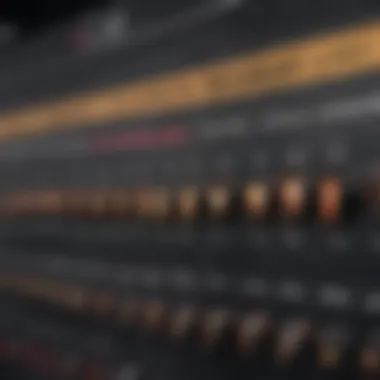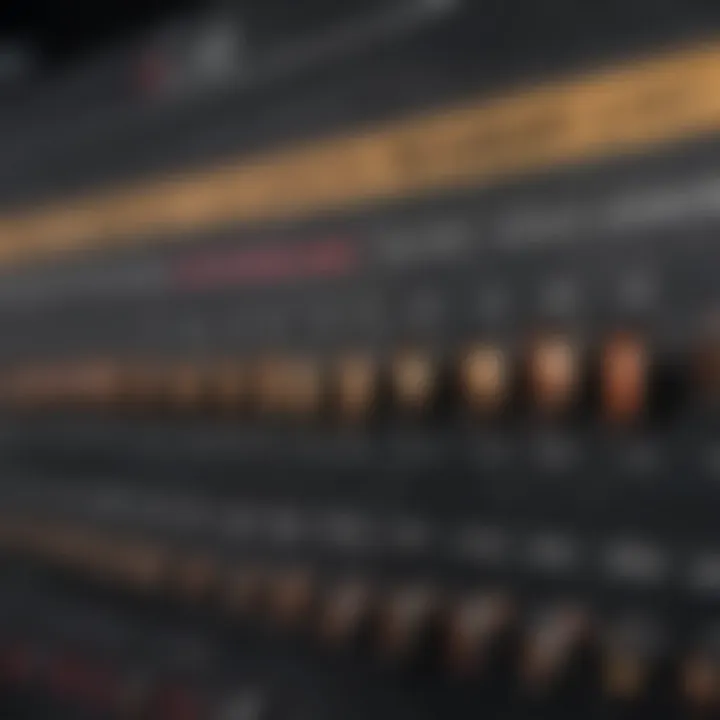Understanding Exigency in Music: Artists & Audiences


Intro
Exigency in music is increasingly relevant in today's complex landscape. This phenomenon highlights the interaction between artists and audiences. With evolving technologies and changing cultural perspectives, both parties feel pressure to adapt. Understanding this dynamic creates valuable insights for musicians and listeners alike.
In the music industry, exigency is not merely a buzzword. It captures the essence of expectations. Audiences seek meaningful connections, while artists strive for authenticity. These desires shape the creation and reception of music, leading to a nuanced interplay of demands and responses.
This article will delve into how various factors influence this relationship. From technological advancements to shifts in cultural standards, each element plays a role in defining what exigency means in the contemporary music scene. The pressure artists experience impacts their creative choices, often balancing between artistic expression and commercial viability. These complexities will be examined in depth.
By exploring the framework of exigency, we unveil the delicate balance that defines the music industry. These insights will help aspiring musicians and music enthusiasts understand the challenges at play. In this article, we will also look at the implications for emerging artists navigating this landscape.
In the following sections, we will explore artist profiles, song analysis, and the wider implications of exigency in music. We hope to provide a comprehensive view of this multifaceted topic.
Defining Exigency in Music
Understanding exigency in the context of music is crucial for grasping how artists and audiences interact within this vibrant field. Exigency refers to the pressing needs or demands arising from audience expectations, cultural shifts, and commercial pressures. By exploring this concept, we can demystify the complex dynamics that shape musical expression and influence how artists craft their work. Artists must navigate various elements while maintaining their creative integrity. This delicate balance has significant implications for both their artistic output and the satisfaction of their fan base.
Concept and Origin
Exigency stems from a broader sense of urgency within the music landscape. It originates from the idea that artists must respond to the changing conditions of their environment, whether cultural, social, or economic. Music has always served as a reflection of society's values and conflicts. Thus, exigency can be seen as an artist's response to these external pressures. The term itself has evolved, intertwining with notions of artistic responsiveness to audience demands. As musicians create, they often weigh personal expression against what listeners expect or desire.
These interactions are not new; musicians throughout history have always felt the weight of exigency. For example, classical composers often dealt with the expectations of patrons, while contemporary pop artists face pressures from record labels and streaming algorithms. Understanding the concept’s origin helps in acknowledging the historical weight placed on artists to fulfill these demands.
Exigency vs. Demand
While often used interchangeably, exigency and demand carry distinct meanings in a musical context. Demand refers specifically to the audience's desire for certain genres, styles, or experiences. This demand can be influenced by trends, pop culture, and social media. It's a reflection of consumer behavior and preferences in the music marketplace.
On the other hand, exigency encompasses a broader spectrum, including the pressures that stem from these demands. It addresses the need for artists to not only meet audience expectations but also to do so while staying true to their musical voice. This nuance is vital in understanding the tensions that can arise when artists feel compelled to conform to popular trends.
"Artists often face a dual challenge: catering to the demands of their audience while preserving the authenticity of their work."
The distinction between exigency and demand becomes increasingly critical as technology continues to change how music is both produced and consumed. Digital platforms and social media amplify audience voices, making the expectation for immediacy more pronounced. As a result, artists must constantly balance these competing forces to thrive in a competitive marketplace.
The Role of Audience Expectations
Audience expectations are a crucial component in the music industry. They shape an artist’s direction and influence the creative process. In this section, we will examine how these expectations arise from various factors and how they affect both the artists and the audience themselves.
Cultural Context
Cultural context plays a significant role in determining what audiences expect from music. Different regions and communities have distinct musical traditions. These traditions create a framework within which audiences interpret and evaluate new music. For example, fans of traditional folk music may expect storytelling and acoustic instrumentation, while listeners of electronic music may lean towards innovative sounds and beats.
The environment in which one grows up can influence musical tastes significantly. Social norms, shared experiences, and cultural heritage shape the sounds that listeners pursue. Moreover, the exposure to diverse musical styles can expand horizons but also complicate expectations. This creates a dynamic interaction between what artists produce and how audiences receive it. Understanding this cultural dimension is crucial for musicians aiming to connect with their listeners.
Commercial Influences
Commercial influences further complicate audience expectations. In a competitive industry, artists often feel pressured to adapt to market trends. Record labels and promoters can push for specific sounds that they believe will attract a larger audience. This leads to a constant negotiation between individuality and commercial viability.
Modern technology has changed the landscape of artist promotion. With streaming services like Spotify and Apple Music, audience feedback is instantaneous. Charts and playlists guide what is considered successful or relevant. This reflects a growing tendency to favor popular sound over artistic exploration.
"The pressure to conform to commercial standards can stifle creativity, compelling artists to create music that resonates more with market demands than their personal vision."
In addition to this, social media plays a role in shaping expectations. Platforms such as Facebook and Instagram allow fans to voice opinions and share thoughts on new releases. The immediate nature of this feedback can dictate an artist's next steps. This often results in an ongoing cycle, where artists continuously adjust their work to meet audience demands.
Overall, understanding audience expectations within these contexts is essential for artists and industry stakeholders alike. They must negotiate these demands carefully, balancing their artistic integrity with the need to succeed in an ever-evolving market.
Implications for Artists


Understanding exigency in music has significant implications for artists. As they navigate the landscape of both artistic expression and audience expectations, they face crucial elements that shape their careers. An artist’s ability to strike a balance can determine not only their success but also their future relevance. Balancing integrity and commercial success remains a primary concern. Artists must navigate the need to create music that resonates with listeners while also staying true to their own artistic vision.
Balancing Integrity and Commercial Success
For many artists, maintaining artistic integrity in a commercial world can be challenging. The pressure to produce hits often compels musicians to conform to mainstream trends or specific audience preferences. This can manifest in various ways:
- Compromised Creativity: Artists might sacrifice their unique sound and vision just to fit into popular genres. This can lead to an increase in formulaic productions aimed at maximizing sales and streams.
- Public Image Concerns: The image a musician projects can also be influenced by commercial considerations. Some artists may feel pressured to adopt a certain persona that attracts more listeners, rather than fully representing themselves.
- Quality vs. Quantity: With the advent of streaming platforms, there is now more pressure to release music regularly. This can sometimes result in lower quality or rushed projects just to maintain visibility in a saturated market.
Nevertheless, there are benefits to balancing these two aspects. Artists who manage both commercial success and their integrity can:
- Cultivate a loyal fan base that appreciates their authenticity.
- Generate sustainable careers, as audiences often gravitate towards genuine artistry rather than fleeting trends.
- Experiment within their craft while finding ways to appeal to larger audiences.
Navigating Audience Demands
Artists must also navigate the evolving demands of their audiences. This process can be complex, as different factors influence what listeners expect:
- Cultural Trends: Current sociopolitical issues can shape audience expectations. Artists addressing relevant themes often find more connection with listeners.
- Social Media Influence: Platforms like Facebook and Reddit allow fans to express desires and critique music directly, creating a dialogue that artists must consider in their work.
- Fan Engagement: Involving fans in the creative process, whether through pre-release feedback or interactive content, can help artists gauge what resonates with their audience. This two-way communication fosters a sense of community and loyalty.
Case Studies of Artist Responses
The examination of case studies regarding artist responses provides critical insights into how musicians navigate the pressures of exigency. These case studies highlight both mainstream and independent artists, allowing an understanding of the diverse strategies they deploy. Analyzing their responses can uncover patterns that shed light on the broader implications of audience expectations and the resultant artistic choices.
The benefits of employing case studies are manifold. They demonstrate real-world applications of theoretical concepts, helping to ground abstract discussions in observable behaviors. Moreover, they present a canvas to assess the outcomes of different approaches within diverse contexts. Such insights are invaluable for music enthusiasts and aspiring musicians looking to understand the interplay of artistic integrity and audience demand.
Artists often face unique challenges in balancing their creativity with the exigencies imposed by their listeners. These case studies reveal not only successful strategies but also cautionary tales of misalignment between artistic vision and audience expectations. Therefore, this section aims to explore these dynamics in detail, highlighting key findings that serve as both guidance and insight for current and future musicians.
Mainstream Artists
Mainstream artists like Taylor Swift and Drake embody the complex relationship between creativity and audience expectations. Both artists have shown adeptness in responding to market trends while maintaining their distinctive artistic styles. Taylor Swift’s transition from country to pop is a prime example of an artist responding to audience demands. Her understanding of what her fans wanted helped propel her to commercial success without sacrificing her artistic identity.
Drake, too, illustrates a keen awareness of the music landscape. He often collaborates across genres, appealing to a wide audience while still nurturing his unique sound. These strategies underscore an important lesson for mainstream artists: adapting to the audience’s demands can lead to greater influence and reach.
Independent Artists
The narrative for independent artists often contrasts sharply with that of their mainstream counterparts. Artists like Chance the Rapper and Billie Eilish have built significant followings through organic engagement rather than large label support. They rely heavily on genuine connections with their audiences, which allows them to explore artistic avenues that feel authentic to them.
Chance the Rapper’s innovative release strategies, such as his free mixtapes, challenge conventional music distribution norms. This approach resonates with listeners, creating an environment where exigency stems from mutual respect rather than obligation. Billie Eilish, with her low-key production style and emotional honesty, caters to a specific cultural zeitgeist, addressing themes that resonate deeply with her audience and encouraging fan engagement on platforms like Instagram.
In both cases, independent artists underline the potential for a fulfilling musical career outside the mainstream paradigms. Their responses to exigency emphasize the importance of authenticity, suggesting that staying true to oneself can foster a loyal and engaged audience.
These case studies of both mainstream and independent artists illuminate the myriad pathways musicians can take to navigate the demands placed upon them by their audiences. Understanding their responses to exigency not only highlights the necessity for adaptability in the music industry but also stresses the significance of staying connected to one’s artistic core.
The Evolution of Music Genres
The evolution of music genres plays a critical role in understanding exigency in the music industry. It reflects how changing audience expectations shape the creative landscape, while also revealing the artistic responses musicians make over time. Genres are not static, as they evolve and blend, influenced by cultural shifts and technological advancements. This section highlights the intersection of historical perspectives and genre innovation, articulating the importance of adaptability in both music creation and consumption.
Historical Perspectives
Examining historical perspectives helps to contextualize the shifts in music genres. Each era possesses its distinctive sound, often influenced by social, political, and cultural events. For instance, the emergence of jazz in the early 20th century coincided with the Great Migration in the United States, where African Americans influenced musical styles incorporating blues and ragtime. Similarly, the 1960s saw the rise of rock and roll, a genre deeply connected to youth rebellion and counterculture movements.
These historical milestones not only mark the transformation of genres, but they also illustrate the exigencies imposed by audiences. As listeners seek new experiences, artists are compelled to innovate. Therefore, the historical context plays a fundamental role in framing the current state of music genres and their evolution.
Genre Blending and Innovation
Genre blending has become increasingly prevalent in recent decades. The barriers that once defined musical styles have weakened, allowing for a rich tapestry of sounds and influences. For example, mainstream pop now frequently incorporates elements of hip-hop, electronic, and traditional world music. This blending leads to innovative creations that sometimes generate new, hybrid genres like reggaeton.


Artists today often leverage technology and digital distribution to experiment and disseminate their music. The rise of platforms like SoundCloud and Bandcamp allows musicians to reach global audiences without traditional gatekeepers. As a result, listeners have greater access to diverse sounds, prompting them to expect varied and innovative music.
"The blending of genres is not just an artistic choice; it is a response to an audience that seeks novelty and engagement. Artists must navigate these expectations to remain relevant."
Through this lens, the evolution of music genres serves as a testament to the relationship between artists and audiences. It highlights the demands placed on musicians to balance commercial success with the desire for authenticity and creative expression. Understanding these dynamics is essential for aspiring musicians, as they must navigate the intertwining worlds of audience expectation and genre evolution.
Technology and Its Impact
Technology plays a crucial role in shaping the music industry today. It influences how music is produced, distributed, consumed, and promoted. The rise of digital platforms has fundamentally altered the relationship between artists and audiences. Understanding these impacts is essential for both musicians and listeners who want to navigate the modern landscape.
Digital Distribution
Digital distribution has transformed how artists share their music. With platforms like Spotify, Apple Music, and Bandcamp, musicians can reach global audiences. This accessibility is one of the most significant changes in the industry. It enables independent artists to bypass traditional gatekeepers, such as record labels. It allows for more diverse music to emerge. However, this democratization also presents challenges.
- Revenue Models: While digital platforms offer wide access, the revenue for streaming is often minimal per play. Many artists struggle to earn a sustainable income. The shift has led to discussions about fair compensation in the era of streaming.
- Market Saturation: The volume of music available online can overwhelm listeners. Many find it hard to discover new artists, which can dilute the impact of individual releases.
Social Media Influence
Social media is another key aspect of technology's impact on music. Platforms like Instagram, Twitter, and TikTok have become vital tools for promotion and artist-fan engagement. Artists actively use these platforms to build their brands and connect with their audiences.
- Promotion: Creators share snippets of their songs, behind-the-scenes content, or personal stories to attract followers. This strategy generates buzz and anticipation for new releases.
- Engagement: Social media usage allows artists to receive immediate feedback. They can gauge audience reactions and adjust their artistic direction based on this input. This interaction, however, also raises pressure on artists to constantly engage and perform.
The relationship between artists and their audience has evolved. Now, musicians must juggle creativity with the demands of technology and social media.
Understanding these technological elements is vital for recognizing how exigency manifests in music. They shape not only what music is available but also how it is created and experienced by audiences around the world.
Exigency versus Authenticity
In the music industry, exigency and authenticity represent two intersecting domains that profoundly influence the career trajectories of artists. The pressure to meet audience demands often conflicts with the genuine expression of the artist's creative vision. Understanding the nuances of this relationship is vital for musicians trying to navigate the challenges of their craft while maintaining their artistic integrity. The balance between fulfilling expectations and staying true to one's self is what makes this topic particularly relevant in today's rapidly evolving music landscape.
Defining Authenticity in Music
Authenticity in music can be described as the genuine expression of an artist's identity, emotions, and experiences. It is about creating music that resonates personally with both the artist and their audience. Authenticity is not just a buzzword; it encompasses various factors that reflect the artist's intent, genre influences, and cultural background.
- Personal Connection: Authenticity comes from music that reflects the artist's life and beliefs.
- Cultural Significance: Different genres carry their own cultural weight, and artists often draw from these backgrounds to enhance their authenticity.
- Sound and Style: Artists who maintain a distinctive sound, without succumbing to mainstream trends, often earn respect for their authenticity.
The problem emerges when the exigencies of the music industry impose constraints on this authenticity. Artists may feel pressured to conform to popular trends or commercial demands, which can dilute their authentic voice.
Case Examples of Authenticity Challenges
The tension between exigency and authenticity has manifested in various ways throughout musical history. Here are a few examples that highlight this struggle:
- Bob Dylan's Transition: In the 1960s, Bob Dylan faced criticism when he shifted from folk to electric rock. This move was both an artistic evolution and a response to audience expectations. While some applauded his innovation, others saw it as a betrayal of his initial authenticity.
- Taylor Swift's Genre Shift: Taylor Swift's transition from country to pop sparked debates about her authenticity. Critics claimed she was compromising her roots for commercial success. Nonetheless, Swift argues that her artistic journey reflects genuine growth as an artist and person.
- Kanye West's Experimentation: Kanye West is known for his unpredictable musical style, which often defies genre norms. His work illustrates the struggle between maintaining an authentic voice and responding to commercial pressures. Despite this, West frequently challenges the notion of authenticity, suggesting that artistic expression is fluid.
"Authenticity is not about sticking to a specific genre. It's about the representation of one's internal dialogue."
These examples show that the impact of exigency can lead to polarizing perceptions of an artist's authenticity. For many, the road to success involves navigating external expectations without compromising core values.
Audience Reception and Critique
Audience reception and critique play a crucial role in understanding exigency in music. The relationship between artists and their audiences is complex, characterized by ongoing interaction and feedback. This dynamic shapes not only the music that is produced but also influences how artists regard their own work and the decisions they make creatively. When audiences engage actively with music, their reception can define an artist's success or failure in subtle ways.
Critical Reviews
Critical reviews are an essential aspect of the music industry. They provide insight into how experts perceive various works. Critics assess multiple elements, like originality, production quality, and emotional impact. A favorable review from a respected source can enhance an artist's reputation, leading to increased visibility. Conversely, negative critiques can hinder an artist’s reach and success.


Artists often navigate the tension between creating music true to their vision and adapting to feedback from critics. Even if some artists prioritize commercial viability, they must consider the weight of expert opinions on their artistry. Critics can reflect broader audience sentiments or set trends and expectations that artists must heed.
"Critics not only evaluate but also lead the discourse around music, shaping public perception."
Fan Feedback and Engagement
Fan feedback is another critical layer of audience reception. In today's digital age, platforms like social media enable fans to express their opinions directly and immediately. This direct line of communication can influence an artist’s direction significantly. Engagements through comments, shares, and likes provide artists with real-time insights into what resonates with their audience.
Fans often cultivate communities around shared musical interests. Their passion can drive artists to adapt and evolve, often pushing creative boundaries. However, this can also lead to dilemmas, where artists feel pressured to cater to popular demand rather than their artistic instincts.
In summary, audience reception encompasses both critical reviews and fan engagement. Both elements intertwine, shaping an artist's career and the music landscape. Understanding this interplay is essential for anyone entering or studying the music industry. It highlights the delicate balance musicians must strike in their pursuit of authenticity while also addressing the exigencies posed by their audiences.
Exigency in Different Cultures
Exigency in music varies significantly across cultures. It shapes not only what artists create but also how audiences perceive and engage with music. This section explores the global nature of exigency, examining how different cultural contexts impact musical expression and audience expectation.
Global Variations
Understanding global variations in music exigency reveals how cultural factors influence artists. For instance, in cultures where music serves as a vital communication tool, such as in many African societies, the expectations placed on musicians may emphasize storytelling and tradition over commercial success. Artists may face the demand to preserve historical narratives, while in Western contexts, the exigency might skew towards innovation and marketability.
- Examples of Global Variations:
- In India, Bollywood music intertwines narrative demands with audience expectations for catchy melodies, creating a unique blend.
- In Japan, the genre of J-Pop must frequently adapt to changing trends, reflecting societal shifts and consumer preferences.
This diversity illustrates that exigency is not a uniform demand but rather a complex interplay between cultural identity and individual expression.
Cultural Influences on Exigency
Cultural influences significantly determine how exigency manifests in music. Different societies prioritize various aspects of music, which in turn molds the expectations placed on artists. Elements such as tradition, social roles, and historical experiences create a rich tapestry that shapes musical exigency.
For example, in regions where music is linked to ritualistic practices, like in Indigenous cultures, the expectation for authenticity and respect for tradition is paramount. Artists often navigate these rigid frameworks to connect with audiences meaningfully.
- Key Influences:
- Tradition: Cultures with a strong emphasis on heritage often demand artists to align their work with longstanding customs.
- Innovation: Rapid technological advancements in some regions press artists to innovate continuously, aligning their work with contemporary tastes.
"Understanding cultural influences on exigency can aid artists in finding their identity within the global music landscape, appreciating the diverse expectations that come with different audiences."
This interplay of cultural background and musical expression highlights the need for artists to balance their personal artistry with the demands posed by their cultural milieu. By engaging with these cultural dynamics, musicians can better articulate their messages within their unique contexts.
Future Outlook of Exigency in Music
The landscape of music is ever-evolving. Understanding the future of exigency in this realm is crucial for both artists and audiences. This section will explore possible directions music may take as societal factors change and technology continues to advance. The increasing intersection of culture and commerce plays a significant role in shaping this future.
As consumer habits evolve, so does the demand for music that resonates with listeners on various levels. The relationship between artist and audience will likely shift in response to these changing dynamics. Here, we analyze several pertinent themes that will help project the outlook for exigency in music.
Predictions and Trends
The predictions surrounding the engagement of audiences with music indicate a progressive trend towards personalization and inclusivity.
- Increased Personalization: With data analytics becoming more sophisticated, platforms like Spotify and Apple Music tailor music recommendations to individual tastes. As artists gain access to these tools, they may find it easier to cater to specific audience preferences, creating niches within genres.
- Blending of Genres: The phenomenon of genre-blending will continue. As artists draw from diverse influences, they will challenge traditional categorizations. This creates new opportunities for artists to connect with varied audiences.
- Technological Innovations: As technology advances, new formats for music consumption will emerge. For example, augmented and virtual reality could offer immersive musical experiences. This may reshape audience expectations and define what exigency looks like in artistic expression.
- Consumer Engagement: Audiences are expected to become more active participants rather than passive consumers. Social media will play a pivotal role in this shift, allowing listeners to express preferences and give feedback more directly to artists.
"The future of music lies not only in what sounds good, but also in how deeply it resonates with the individual experience."
Implications for Emerging Artists
Emerging artists face unique challenges in this evolving landscape. Understanding exigency is crucial for their survival and success. Here are some considerations they should keep in mind:
- Building a Personal Brand: In a crowded market, it is essential for new artists to create a distinct identity. This means more than just musical style; it involves crafting a narrative that resonates with potential fans.
- Authentic Engagement: Maintaining authenticity in interaction is vital. Audiences appreciate when artists are genuine about their process and ethos. This can foster a loyal following, which is important for sustaining a musical career.
- Adapting to Change: Flexibility in musical style and marketing strategies will be necessary. Emerging artists must adapt to trend shifts and technological improvements to stay relevant.
- Networking and Collaboration: Engaging with other artists, producers, and industry professionals can offer support. Collaboration can also lead to greater exposure and help navigate the challenges of the music industry.
By staying aware of these trends and implications, emerging artists can effectively position themselves within the new exigencies of the music world.







